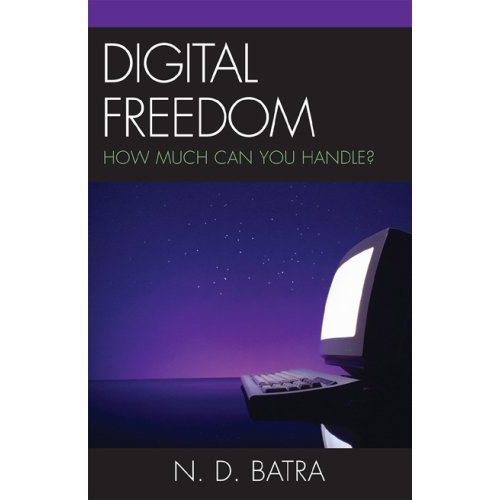cyber age: ND Batra
From The Statesman
Digital spies, nowhere to hide
From time to time many US Senators say how deeply concerned they are the way the USA is gradually slipping into a low-intensity surveillance society. Since the terrorist attacks four year ago, there’s a diffused sense of insecurity, which flares up occasionally. The Americans are quietly submitting to whatever brings them a feeling of assuredness. While they protest against intrusiveness by the government, businesses dig into their personal lives with near impunity. Protests remain muted.
Senator Shelby told a congressional privacy caucus a few years ago, “It would appear that while you use the Internet, the Internet is using you. You can get more information of a computer (about an individual) than a wiretap. What concerns me is the national implications to this.” The Senator was referring to web bugs and other online surveillance devices that are being increasingly used by businesses to track users when they surf their websites. Tracking is done unobtrusively and the user can never suspect that he is being watched; nonetheless, the practice is questionable, especially when the Website does not declare it in its privacy policy.
Most of us are familiar with cookies, small software programmes the advertisers put on our hard drives to track where we surf so that they can customise the most appropriate advertising message for us to achieve target marketing, reaching the right person with the right message. But web bugs are different. These tracking technology devices can be programmed to collect whatever data is required without the user’s knowledge. For example, a web bug can be programmed to look at a data file on a networked desktop without leaving a trace that data has been touched at all.
When you look at your online mutual fund statement, the web bug too could be monitoring it. A few companies do inform their visitors about the tracking devices they use and for what purposes. Some companies use web beacon, a single-pixel picture, to count and identify users. A web beacon can track whether a particular message, including junk mail, has been opened and acted upon or not. Any electronic image that is part of a web page, including a banner ad, can be programmed to act as a beacon and spy on the user. Web portals/search companies claim that the information enables them to personalise the surfing experience when a frequent user visits their sites. Some use beacons to do demographic research on behalf of their clients, but assert that no personally identifiable information gathered from the beacon research is shared with the clients.
Users can opt-out, but most of them don’t know whether the option is available, nor do many of them pay attention to the privacy statement. Surveillance technologies are not limited to the Net. Several companies are using biometrics, face recognition, radio frequency and global positioning system (GPS) technologies, to keep a watch on their properties and track suspects.
Many car rental companies in the USA use GPS to keep track of their rental cars. If a car is stolen or is involved in an accident, the company would know the exact location of the car. GPS also enables them to check the speed of a rental car.
In July 2001, for example, Acme Rent-a-Car of New Haven, Connecticut charged one of its renters $400 for exceeding the speed limit, which it tracked with GPS; but the Connecticut department of consumer protection sided with the renter and did not allow Acme to collect the fine.
It also raised an intriguing legal question whether a private car company can act as traffic police and penalise the offender.
Many airports have been using digital fingerprint identification technology from Visionics Corporation to conduct background checks without any protest from employees.
Face recognition technology is being extensively used not only in airports but also in ballparks, banks and other business establishments.
If a suspect turns up, his face is digitally matched in seconds with the image database. It is not a foolproof system; for example, a man with sunglasses could not be identified with face recognition technology. So far no terrorist has been apprehended by face recognition technology, but the security business is booming the USA. The US Customs and some airports are using low-dose x-ray machines, such as Body Search, to electronically scan a person for drugs, bombs and contrabands. Body Search electronically strips a person naked and projects the image on the screen for scrutiny without the person being asked to take her clothes off – all in the name of security.
Hundreds of air travellers, including women, are randomly subjected to electronic Body Search.An interesting security tracking technology is the radio-frequency identification tag (RFID), which is attached to a suspect’s baggage as he checks in. The tagged baggage is automatically routed to a security area where it is screened with special cameras and sensors for explosives and other hazardous materials.
What’s our digital future? Along with our baggage, we too might have to wear radio-frequency ID tags so that we can be monitored as we move from one airport to another, from country to country via GPS. It may not increase security, but it surely is going to be multi-billion dollar business, thanks to the perpetuation of fear created by Al-Qaida. How ironic that terrorism creates business opportunities for some.
Tuesday, June 28, 2005
DIGITAL SPIES, NOWHERE TO HIDE
at Tuesday, June 28, 2005 Posted by Narain D. Batra
Subscribe to:
Post Comments (Atom)

Hey, you have a great blog here!
ReplyDeleteI have a web site traffic generation site. It pretty much covers ##WEBSITE TRAFFIC## related stuff.
Come and check it out if you get time.
I'm new to blogging so sorry if it's not right for your blog.
Hope to see your blog grow.
Thanks again